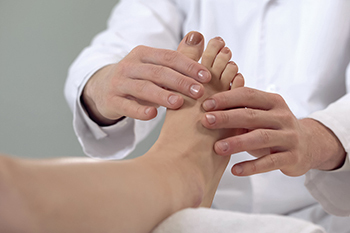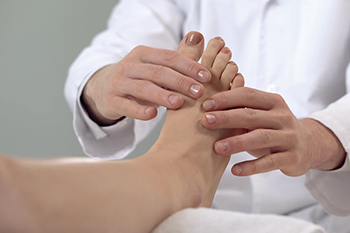Connect With Us
Blog
Items filtered by date: September 2022
What Is Sever’s Disease?

Sever’s disease is a common overuse injury that affects the heels in growing children. This typically occurs in children ages seven to 14 when their bodies are undergoing rapid growth. Pain may develop due to inflammation where the Achilles tendon inserts into the growth plate located in the heel bone. Activities, like running and jumping can exacerbate the stress on the heel bone’s growth plate and cause pain. As might be expected, this affliction is most often seen in young athletes who participate in sports including soccer, gymnastics, football, and basketball. Such pain often goes away with rest and worsens the activities that caused it. It can be in one or both heels and a child might start limping or walking on their toes to avoid putting pressure on their heels. Resting the affected foot/feet is the best course of action. If the pain does not subside after a short period of time, take your child to a podiatrist who can properly diagnose the condition and treat it appropriately.
Sever's disease often occurs in children and teens. If your child is experiencing foot or ankle pain, see one of our podiatrists from Bergen Foot & Ankle. Our doctors can treat your child’s foot and ankle needs.
Sever’s Disease
Sever’s disease is also known as calcaneal apophysitis, which is a medical condition that causes heel pain I none or both feet. The disease is known to affect children between the ages of 8 and 14.
Sever’s disease occurs when part of the child’s heel known as the growth plate (calcaneal epiphysis) is attached to the Achilles tendon. This area can suffer injury when the muscles and tendons of the growing foot do not keep pace with bone growth. Therefore, the constant pain which one experiences at the back of the heel will make the child unable to put any weight on the heel. The child is then forced to walk on their toes.
Symptoms
Acute pain – Pain associated with Sever’s disease is usually felt in the heel when the child engages in physical activity such as walking, jumping and or running.
Highly active – Children who are very active are among the most susceptible in experiencing Sever’s disease, because of the stress and tension placed on their feet.
If you have any questions, please feel free to contact our offices located in Fort Lee, NJ and Flushing, NY . We offer the newest diagnostic and treatment technologies for all your foot and ankle injuries.
Flexible Flat Feet

Most babies are born with flat feet, but the arch fully develops during the teenage years. There are some children that have a joint hypermobility condition, and this is referred to as low muscle tone. This may prevent the arch from developing, which could result in having flat feet in their adult years. One type of flat feet is called flexible flat feet. The ligaments hold the bones in place in addition to supporting the arches. Children who have joint hypermobility do not have the same support as those without it, and the ligaments are more flexible than normal. There are stretches and exercises that can be performed that may help to strengthen the arch. An effective stretch is done by standing up while slightly leaning back. This will propel the muscles in the front of the ankle to become stronger. Additionally, standing on one leg will activate the muscles in the ankle to maintain balance as well as stability. If you have questions about flat feet and would like to learn more about how to perform effective stretches, please schedule a consultation with a podiatrist.
Flatfoot is a condition many people suffer from. If you have flat feet, contact one of our podiatrists from Bergen Foot & Ankle. Our doctors will treat your foot and ankle needs.
What Are Flat Feet?
Flatfoot is a condition in which the arch of the foot is depressed and the sole of the foot is almost completely in contact with the ground. About 20-30% of the population generally has flat feet because their arches never formed during growth.
Conditions & Problems:
Having flat feet makes it difficult to run or walk because of the stress placed on the ankles.
Alignment – The general alignment of your legs can be disrupted, because the ankles move inward which can cause major discomfort.
Knees – If you have complications with your knees, flat feet can be a contributor to arthritis in that area.
Symptoms
- Pain around the heel or arch area
- Trouble standing on the tip toe
- Swelling around the inside of the ankle
- Flat look to one or both feet
- Having your shoes feel uneven when worn
Treatment
If you are experiencing pain and stress on the foot you may weaken the posterior tibial tendon, which runs around the inside of the ankle.
If you have any questions please feel free to contact our offices located in Fort Lee, NJ and Flushing, NY . We offer the newest diagnostic and treatment technologies for all your foot and ankle needs.
Surgery for Big Toe Arthritis

Big toe arthritis is a form of osteoarthritis, and it causes the joints of the big toe to become inflamed. This usually affects the first metatarsophalangeal, or MTP joint. This condition can cause pain, numbness, and difficulty in walking. Risk factors can include being older, female, obese, and having muscle weakness or joint injuries. This affliction is often diagnosed with an X-ray to see the amount of space between the joints. Less spacing leads to more severe arthritis. The extent of pain, stiffness, and movement of the big toe are also used to gauge the severity of this condition. While one can try physical therapy, rigid orthotics, and cortisone injections to relieve pain, the most effective long-term treatment for this condition is surgery. Surgical treatments for big toe arthritis include a cheilectomy, which involves removing a portion of the bone within the big toe, or fusing the bones in the big toe, which is referred to as arthrodesis. If you suffer from big toe arthritis and have tried other remedies with little or no relief, please consult with a podiatrist to see if you are a candidate for one of these surgeries.
In certain cases, in which the patient suffers from extreme pain or damage in a joint, joint replacement surgery may be deemed useful. If you have constant pain in a foot joint, consult with one of our podiatrists from Bergen Foot & Ankle. Our doctors will assess your condition and provide you with quality foot and ankle treatment.
What Is Joint Replacement Surgery?
Over time, joints wear down; this can be exacerbated by diseases and conditions. Joint replacement surgery, also known as arthroplasty, is when a damaged joint is surgically removed and replaced with a prosthesis. Prostheses, which can be made of ceramic, plastic, or metal, act as joints in lieu of an actual joint. One of the most prevalent causes for joint replacement is arthritis.
Arthritis in the Foot
Arthritis can occur in any joint in the body, including in the feet. Common types of arthritis in the foot are osteoarthritis, rheumatoid arthritis, and gout. The big toe is usually where arthritis occurs in the foot; this is known as hallux rigidus.
Joint Replacement Surgery in the Foot
The most common form of joint replacement in the foot is a first metatarsophalangeal (MTP) joint placement. MTP joint replacement surgery is designed to treat hallux rigidus. Surgery is not intensive, and recovery occurs within one to two months after the procedure has been done. Overall, joint replacement surgery is a safe and effective way to treat pain in the joint of the foot.
If you have any questions, please feel free to contact our offices located in Fort Lee, NJ and Flushing, NY . We offer the newest diagnostic and treatment technologies for all your foot care needs.
Get Professional Care for a Broken Foot or Ankle
Selecting Shoes For Your Child

As your toddler grows and matures, their feet are also growing and developing at the same time. Since your child’s feet are an important part of their body, selecting the right kind of shoe is imperative to maintaining overall foot health. This is true especially because the bones in a young child’s feet are still soft and ill-fitting shoes can exacerbate any existing foot deformities in a toddler. There are several things to keep in mind when shopping for your child’s shoes. First, you can be mindful of selecting shoes that have velcro straps. This can help ensure that both you and your child can keep the shoes fastened onto the feet. Second, you can look for shoes that have a spacious toe box, which will not crowd the child’s toes. Lastly, in terms of material, it can be important to select shoes that are made of breathable material, such as leather or mesh. This mesh is comparable to that used in running shoes. You may notice that a child will tend to grow out of their shoes at a seemingly rapid pace. However, it is nonetheless important to find shoes that are of high quality for your child. If you are concerned about your child’s shoes, please consult with a podiatrist who can help you.
Making sure that your children maintain good foot health is very important as they grow. If you have any questions, contact one of our podiatrists of Bergen Foot & Ankle. Our doctors can provide the care you need to keep you pain-free and on your feet.
Keeping Children's Feet Healthy
Having healthy feet during childhood can help prevent medical problems later in life, namely in the back and legs. As children grow, their feet require different types of care. Here are some things to consider...
Although babies do not walk yet, it is still very important to take care of their feet.
Avoid putting tight shoes or socks on his or her feet.
Allow the baby to stretch and kick his or her feet to feel comfortable.
As a toddler, kids are now on the move and begin to develop differently. At this age, toddlers are getting a feel for walking, so don’t be alarmed if your toddler is unsteady or ‘walks funny’.
As your child gets older, it is important to teach them how to take care of their feet.
Show them proper hygiene to prevent infections such as fungus.
Be watchful for any pain or injury.
Have all injuries checked by a doctor as soon as possible.
Comfortable, protective shoes should always be worn, especially at play.
If you have any questions please feel free to contact our offices located in Fort Lee, NJ and Flushing, NY . We offer the newest diagnostic and treatment technologies for all your foot and ankle needs.

